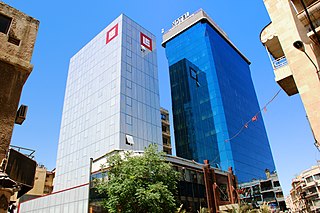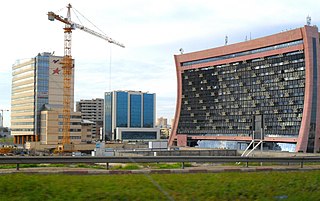Related Research Articles

The economy of the Dominican Republic is the seventh largest in Latin America, and is the largest in the Caribbean and Central American region. The Dominican Republic is an upper-middle income developing country with important sectors including mining, tourism, manufacturing, energy, real estate, infrastructure, telecommunications and agriculture. The Dominican Republic is on track to achieve its goal of becoming a high-income country by 2030, and is expected to grow 79% in this decade. The country is the site of the single largest gold mine in Latin America, the Pueblo Viejo mine.Although the service sector is currently the leading employer of Dominicans, agriculture remains an important sector in terms of the domestic market and is in second place in terms of export earnings. Tourism accounts for more than $7.4 billion in annual earnings in 2019. Free-trade zone earnings and tourism are the fastest-growing export sectors. A leading growth engine in the Free-trade zone sector is the production of medical equipment for export having a value-added per employee of $20,000 USD, total revenue of $1.5 billion USD, and a growth rate of 7.7% in 2019. The medical instrument export sector represents one of the highest-value added sectors of the country's economy, a true growth engine for the country's emerging market. Remittances are an important sector of the economy, contributing $8.2 billion in 2020. Most of these funds are used to cover household expenses, such as housing, food, clothing, health care and education. Secondarily, remittances have financed businesses and productive activities. Thirdly, this combined effect has induced investment by the private sector and helps fund the public sector through its value-added tax. The combined import market including the free-trade-zones amounts to a market of $20 billion a year in 2019. The combined export sector had revenues totaling $11 billion in 2019. The consumer market is equivalent to $61 billion in 2019. An important indicator is the average commercial loan interest rate, which directs short-term investment and stimulates long-term investment in the economy. It is currently 8.30%, as of June 2021.

The economy of Kyrgyzstan is heavily dependent on the agricultural sector. Cotton, tobacco, wool, and meat are the main agricultural products, although only tobacco and cotton are exported in any quantity. According to Healy Consultants, Kyrgyzstan's economy relies heavily on the strength of industrial exports, with plentiful reserves of gold, mercury and uranium. The economy also relies heavily on remittances from foreign workers. Following independence, Kyrgyzstan was progressive in carrying out market reforms, such as an improved regulatory system and land reform. In 1998, Kyrgyzstan was the first Commonwealth of Independent States (CIS) country to be accepted into the World Trade Organization. Much of the government's stock in enterprises has been sold. Kyrgyzstan's economic performance has been hindered by widespread corruption, low foreign investment and general regional instability. Despite those issues, Kyrgyzstan is ranked 70th on the ease of doing business index.

The Economy of Qatar is one of the highest in the world based on GDP per capita, ranking generally among the top ten richest countries on world rankings for 2015 and 2016 data compiled by the World Bank, the United Nations, and the International Monetary Fund (IMF). The country's economy has grown despite sanctions by its neighbors, Saudi Arabia and the United Arab Emirates. Mainly because the country exports primarily to Japan, South Korea, India and China, making the sanctions effectively redundant as neither Saudi Arabia nor the United Arab Emirates have imposed trading penalties such as tariffs or embargoes on either of these countries for trading with Qatar, or offering incentives such as discounts for their own energy exports to reduce Qatari exports.

The economy of Russia has gradually transformed from a planned economy into a mixed market-oriented economy. It has enormous natural resources, particularly oil and natural gas. It is the world's 11th-largest economy by nominal GDP, and 6th-largest by purchasing power parity (PPP). Due to a volatile currency exchange rate, Russia's GDP as measured in dollars fluctuates sharply. Russia was the last major economy to join the WTO, becoming a member in 2012.

Syria's economic situation has been turbulent and their economy has deteriorated considerably since the beginning of the Syrian civil war, which erupted in March 2011.

The economy of Turkmenistan continues to recover from the 2014 downturn in hydrocarbon prices, but remains "in the grip of its worst economic crisis since the immediate post-independence period, driven in part by low gas prices, the suspension of gas exports to Russia between 2016 and 2019...and poor harvests." Former President Gurbanguly Berdimuhamedow at a session of the Cabinet of Ministers on March 11, 2021, called the rate of GDP growth unsatisfactory. When discussing the 2021 government budget, he noted that 2021 would be "as difficult" a year as 2020 had been.

The economy of Ukraine is an emerging, lower-middle income, mixed economy located in Eastern Europe. It grew rapidly from 2000 until 2008 when the Great Recession began worldwide and reached Ukraine. The economy recovered in 2010 and continued improving until 2013. From 2014 to 2015, the Ukrainian economy suffered a severe downturn, with GDP in 2015 being slightly above half of its value in 2013. In 2016, the economy again started to grow. By 2018, the Ukrainian economy was growing rapidly, and reached almost 80% of its size in 2008.

The economy of Mozambique is $14.396 billion by gross domestic product as of 2018, and has developed since the end of the Mozambican Civil War (1977–1992). In 1987, the government embarked on a series of macroeconomic reforms, which were designed to stabilize the economy. These steps, combined with donor assistance and with political stability since the multi-party elections in 1994, have led to dramatic improvements in the country's growth rate. Inflation was brought to single digits during the late 1990s, although it returned to double digits in 2000–02. Fiscal reforms, including the introduction of a value-added tax and reform of the customs service, have improved the government's revenue collection abilities.

The chemical industry comprises the companies and other organizations that develop and produce industrial, specialty and other chemicals. Central to the modern world economy, it converts raw materials into commodity chemicals for industrial and consumer products. It includes industries for petrochemicals such as polymers for plastics and synthetic fibers; inorganic chemicals such as acids and alkalis; agricultural chemicals such as fertilizers, pesticides and herbicides; and other categories such as industrial gases, speciality chemicals and pharmaceuticals.

Saudi Basic Industries Corporation, known as SABIC, is a Saudi chemical manufacturing company. 70% of SABIC's shares are owned by Saudi Aramco. It is active in petrochemicals, chemicals, industrial polymers, fertilizers, and metals. It is the second largest public company in the Middle East and Saudi Arabia as listed in Tadawul.

The National Petrochemical Company (NPC), a subsidiary to the Iranian Petroleum Ministry, is owned by the government of the Islamic Republic of Iran. It is responsible for the development and operation of the country's petrochemical sector. Founded in 1964, NPC began its activities by operating a small fertilizer plant in Shiraz. Today, NPC is the second largest producer and exporter of petrochemicals in the Middle East. Over these years, it has not only expanded the range and volume of its products, but it has also taken steps in areas such as R&D to achieve more self-sufficiency.

Industry is 39.4% of China's gross domestic product (GDP) in 2022. In 2007, industry contributed 46.7 percent of GDP in 2010 and occupied 27 percent of the workforce. In 2015, the manufacturing industrial sectors contributed to 40% of China's GDP. The manufacturing sector produced 44.1 percent of GDP in 2004 and accounted for 11.3 percent of total employment in 2006.
Hydrocarbons are the leading sector in Algeria's mineral industry, which includes diverse but modest production of metals and industrial minerals. In 2006, helium production in Algeria accounted for about 13% of total world output. Hydrocarbons produced in Algeria accounted for about 2.9% of total world natural gas output and about 2.2% of total world crude oil output in 2006. Algeria held about 21% of total world identified resources of helium, 2.5% of total world natural gas reserves, and about 1% of total world crude oil reserves.

The economy of Ivory Coast is stable and currently growing, in the aftermath of political instability in recent decades. The Ivory Coast's economy is largely market-based and depends heavily on the agricultural sector. Almost 70% of the Ivorian people are engaged in some form of agricultural activity. GDP per capita grew 82% in the 1960s, reaching a peak growth of 360% in the 1970s, but this proved unsustainable and it shrank by 28% in the 1980s and a further 22% in the 1990s. This decline, coupled with high population growth, resulted in a steady fall in living standards. The Gross national product per capita, now rising again, was about US$727 in 1996. It was substantially higher two decades before.

Algeria's economy continued to recover in the first half of 2022, led by a return of oil production to pre-pandemic levels and a continued recovery of the service sector along with a more vigorous agricultural activity. The recovery should continue into 2023, supported by the nonhydrocarbon sector and public expenditure growth, according to the latest edition of the World Bank's Algeria Economic Update.

The economy of Belarus is an upper-middle income mixed economy. As a post-Soviet transition economy, Belarus rejected most privatisation efforts in favour of retaining centralised political and economic controls by the state. The highly centralized Belarusian economy emphasizes full employment and a dominant public sector. It has been described as a welfare state or market socialist. Belarus is the world's 74th-largest economy by GDP.

Iran is an energy superpower and the petroleum industry in Iran plays an important part in it. In 2004, Iran produced 5.1 percent of the world's total crude oil, which generated revenues of US$25 billion to US$30 billion and was the country's primary source of foreign currency. At 2006 levels of production, oil proceeds represented about 18.7% of gross domestic product (GDP). However, the importance of the hydrocarbon sector to Iran's economy has been far greater. The oil and gas industry has been the engine of economic growth, directly affecting public development projects, the government's annual budget, and most foreign exchange sources.

The food industry of Russia is a branch of industry in Russia.
The metallurgy industries of Russia make up about 5% of Russia's GDP, about 18% of industrial production and about 14% of exports, as of 2009. The volume of metallurgical production was 1.87 trillion rubles (2009). Investments in fixed assets in metallurgy were 280 billion rubles (2008). The average salary in the metallurgical industry was 23,258 rubles / month.

Industry plays an important role in the economy of Belarus. In 2020, industry accounted for 25.5% of Belarusian GDP. Share of manufacturing in Belarusian GDP was 21.3% in 2019. United Nations Economic Commission for Europe described Belarus as having "a well-developed industrial sector and highly skilled workforce". In 2020, 23.5% of Belarusian workforce was employed in industry. In 2019, total industrial production amounted to 115.7 billion Belarusian rubles ; in 2020, it rose to Rbls 116.5 billion. Belarusian industry is export-oriented: in 2020, 61.2% of industrial output was exported. The most important sector is food industry. Other well-developed sectors of industry include chemical industry, automotive industry and manufacturing of other machinery equipment.
References
- ↑ Exports by commodity and commodity groups in the context of HS Russia Archived 2009-12-18 at the Wayback Machine / / Rosstat
- ↑ 6 -0.htm living Standards [ permanent dead link ] / / Rosstat
- ↑ "Russian sanctions hurt chemical industry". Chemistry World. Retrieved 14 June 2016.
- ↑ "Давыдов Эдуард Маликович — карьера главы БСК (лидер в химпроме РФ)". www.kremlinrus.ru. Retrieved 2023-08-07.